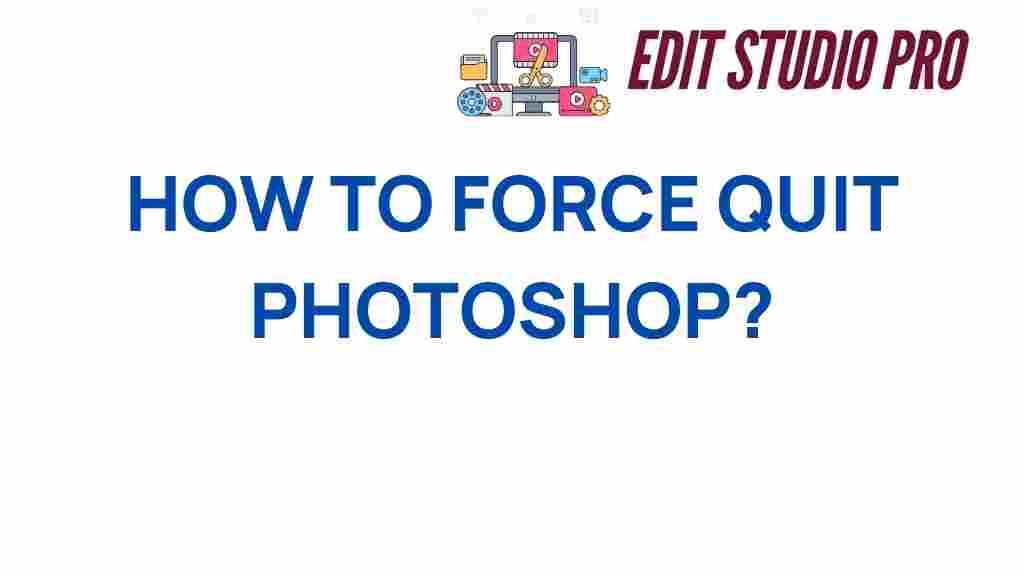Mastering the Art of the Force Quit: Photoshop’s Hidden Solution
When working with Adobe Photoshop, a powerful tool for digital editing, users may occasionally encounter issues that cause the software to freeze or become unresponsive. In such cases, knowing how to effectively force quit Photoshop can be a lifesaver. This article delves into the hidden solution of force quitting, providing essential troubleshooting tips for both Mac and Windows users, ensuring your creative tools remain efficient, and your system performance is optimized.
Understanding the Need to Force Quit Photoshop
Photoshop is a complex program that requires significant system resources to operate smoothly. If you find yourself facing performance issues, crashes, or unresponsive behavior, it is crucial to assess the situation quickly. Understanding when and how to force quit can save your work and prevent further frustration.
Why Does Photoshop Freeze?
- Excessive Resource Usage: Large files or multiple layers can strain your system.
- Corrupt Preferences: Sometimes, corrupted preferences can lead to unexpected behavior.
- Outdated Software: Running an outdated version of Photoshop may lead to bugs and crashes.
- Insufficient RAM: If your system lacks enough RAM, Photoshop may struggle to function properly.
When faced with these issues, the force quit function is often the quickest solution to regain control of your computer. Let’s explore how to do this on both Mac and Windows platforms.
How to Force Quit Photoshop on Mac
On a Mac, force quitting an application is straightforward. Follow these steps:
Step-by-Step Guide
- Use the Apple Menu:
- Click on the Apple logo in the top-left corner of your screen.
- Select “Force Quit…” from the dropdown menu.
- Keyboard Shortcut:
- Press Command + Option + Esc simultaneously to open the Force Quit Applications window.
- Select Photoshop:
- In the Force Quit window, find and select “Adobe Photoshop.”
- Force Quit:
- Click the “Force Quit” button to close the application.
Once Photoshop has been closed, you can relaunch it. Be sure to save your work frequently to minimize data loss.
How to Force Quit Photoshop on Windows
For Windows users, the process is equally simple. Here’s how to force quit Photoshop:
Step-by-Step Guide
- Use Task Manager:
- Press Ctrl + Shift + Esc to open the Task Manager directly.
- Alternatively, you can right-click on the taskbar and select “Task Manager.”
- Locate Photoshop:
- In the Task Manager window, find “Adobe Photoshop” under the “Processes” tab.
- End the Task:
- Select Photoshop and click on the “End Task” button in the bottom right corner.
After force quitting, you can restart Photoshop. Remember to check for any unsaved changes before quitting.
Troubleshooting Tips for Photoshop Performance
After a force quit, it’s essential to ensure that your Photoshop experience is smooth moving forward. Here are some troubleshooting tips to enhance your software performance:
1. Update Photoshop Regularly
Keep your software updated to the latest version. Adobe frequently releases updates that fix bugs, improve performance, and introduce new features. To update:
- Open the Adobe Creative Cloud app.
- Check for updates under the “Apps” tab.
- Install any available updates for Photoshop.
2. Optimize Preferences
Photoshop’s preferences can significantly affect performance. Adjust these settings:
- Navigate to Edit > Preferences > Performance.
- Adjust Memory Usage to allocate more RAM to Photoshop.
- Enable Use Graphics Processor if your system supports it.
3. Manage Scratch Disks
Scratch disks are used by Photoshop when your system runs low on RAM. To manage scratch disks:
- Go to Edit > Preferences > Scratch Disks.
- Select a disk with ample free space and prioritize it.
4. Clear Cache Regularly
Clearing the cache can help improve performance. To clear your cache:
- Go to Edit > Purge.
- Select what you want to purge (Clipboard, All, History, etc.).
5. Disable Unused Plugins
Plugins can slow down Photoshop. Disable any that you don’t use regularly:
- Navigate to Window > Extensions to manage your plugins.
- Disable or uninstall any unnecessary plugins.
Enhancing System Performance for Photoshop
In addition to troubleshooting within Photoshop, enhancing your overall system performance can lead to a better editing experience. Here are some tips:
1. Upgrade Your Hardware
If you frequently experience performance issues, consider upgrading your hardware:
- Increase RAM: More RAM allows for better multitasking and handling large files.
- SSD Upgrade: If you are still using an HDD, upgrading to an SSD can significantly improve loading times.
2. Close Background Applications
Running multiple applications can strain your system’s resources. Close any unnecessary programs while using Photoshop to free up memory and CPU power.
3. Regularly Maintain Your Computer
Routine maintenance can help keep your system running efficiently:
- Run disk cleanup to remove unnecessary files.
- Defragment your hard drive if you are using an HDD.
- Keep your operating system updated.
Conclusion
Mastering the art of the force quit in Photoshop is an essential skill for any digital editor. By understanding when and how to force quit, along with implementing effective troubleshooting tips, you can ensure a smoother experience with this powerful software. Whether you’re on Mac or Windows, knowing these techniques enhances your productivity and keeps your creative tools functioning optimally.
Remember to keep your software updated and optimize your system performance for the best results. For more tips on troubleshooting and enhancing your digital editing experience, check out our comprehensive guide. If you’re looking for community support, visit the Adobe Community Forums to connect with fellow Photoshop users.
This article is in the category Tips & Tricks and created by EditStudioPro Team
